1991 MITSUBISHI 3000GT service
[x] Cancel search: servicePage 1001 of 1146
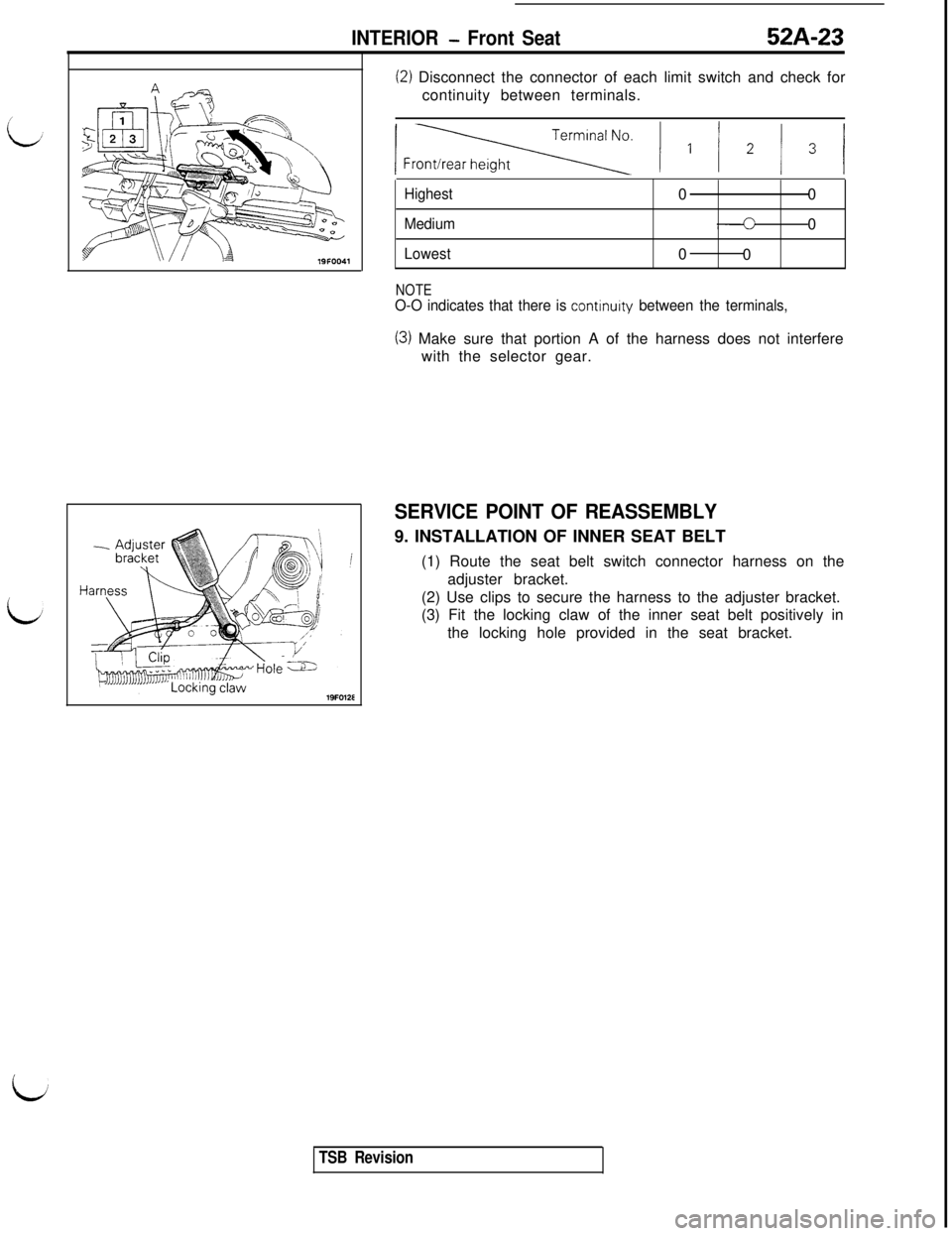
INTERIOR - Front Seat52A-23
(2) Disconnect the connector of each limit switch and check for
continuity between terminals.
lFr= ) I / * / 3 j
Highest00
Medium0
Lowest0
0
NOTEO-O indicates that there is continurty between the terminals,
(3) Make sure that portion A of the harness does not interfere
with the selector gear.
SERVICE POINT OF REASSEMBLY9. INSTALLATION OF INNER SEAT BELT
(1) Route the seat belt switch connector harness on the
adjuster bracket.
(2) Use clips to secure the harness to the adjuster bracket.
(3) Fit the locking claw of the inner seat belt positively in
the locking hole provided in the seat bracket.
iJ
TSB Revision
Page 1002 of 1146

52A-24INTERIOR - Rear Seat
REAR SEAT
REMOVAL AND INSTALLATION
Rear seat removal steps
l * I)*1. Rear seat cushion
2. Rear seat back
Striker removal steps
3. Quarter trim (Refer to P.52A-14.)4. StrikerlQFtX-I67
Rearseat beltbuckles
Lock dat
Hole in flo\ori-19FOO95
SERVICE POINT OF REMOVAL1. REMOVAL OF REAR SEAT CUSHION
With the lever pulled, raise the seat cushion, and remove
the seat cushion.
SERVICE POINT OF INSTALLATION
1. INSTALLATION OF REAR SEAT CUSHION
(1) Fit the attachment wire of the seat cushion under theseatback positively.
(2)Pass the rear seat belt buckle through the seat cushion.
(3) Insert the lock plate of the seat cushion in the
respective holes provided in the floor.
TSB Revision
Page 1008 of 1146
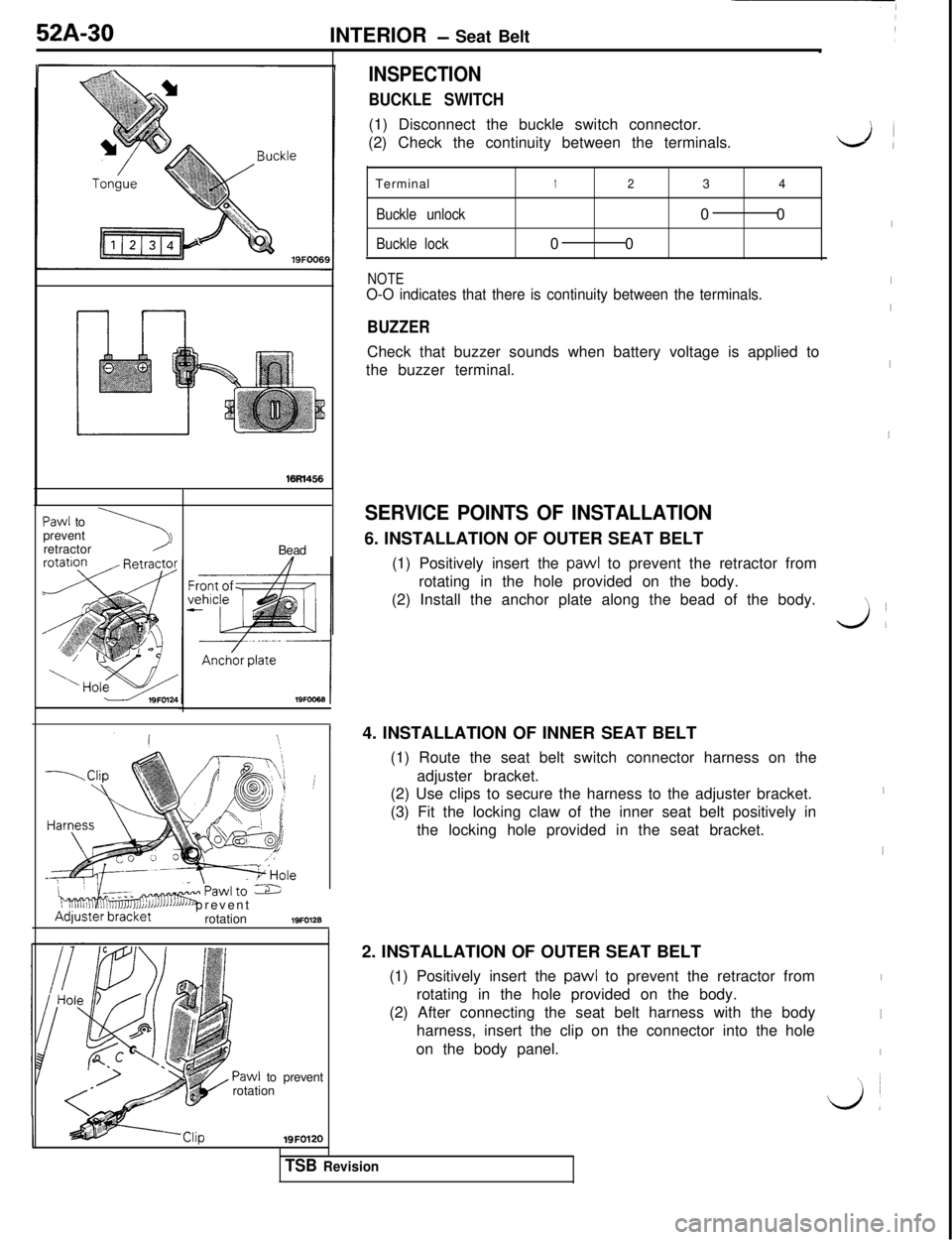
52A-30
INTERIOR - Seat Belt
16M456
NOTEO-O indicates that there is continuity between the terminals.
BUZZERCheck that buzzer sounds when battery voltage is applied to
the buzzer terminal.
Paw1 to
prevent
\1retractor
Bead
INSPECTION
BUCKLE SWITCH(1) Disconnect the buckle switch connector.
(2) Check the continuity between the terminals.
Terminal
1234
Buckle unlock00
Buckle lock00
i
“..i,Tlmdsmrawlro -6I J3JJAdjuster’bracketJ’JJ’ prevent
rotation19FO128
Paw1 to prevent
rotation19FO120
SERVICE POINTS OF INSTALLATION6. INSTALLATION OF OUTER SEAT BELT
(1) Positively insert the
paw1 to prevent the retractor from
rotating in the hole provided on the body.
(2) Install the anchor plate along the bead of the body.
4. INSTALLATION OF INNER SEAT BELT
(1) Route the seat belt switch connector harness on the
adjuster bracket.
(2) Use clips to secure the harness to the adjuster bracket.
(3) Fit the locking claw of the inner seat belt positively in
the locking hole provided in the seat bracket.
2. INSTALLATION OF OUTER SEAT BELT
(1) Positively insert the
paw1 to prevent the retractor from
rotating in the hole provided on the body.
(2) After connecting the seat belt harness with the body
harness, insert the clip on the connector into the hole
on the body panel.
LA
I
I
I
I
I\
Jl
I
I
I
I
I
\ ~
L&l
TSB Revision
Page 1011 of 1146
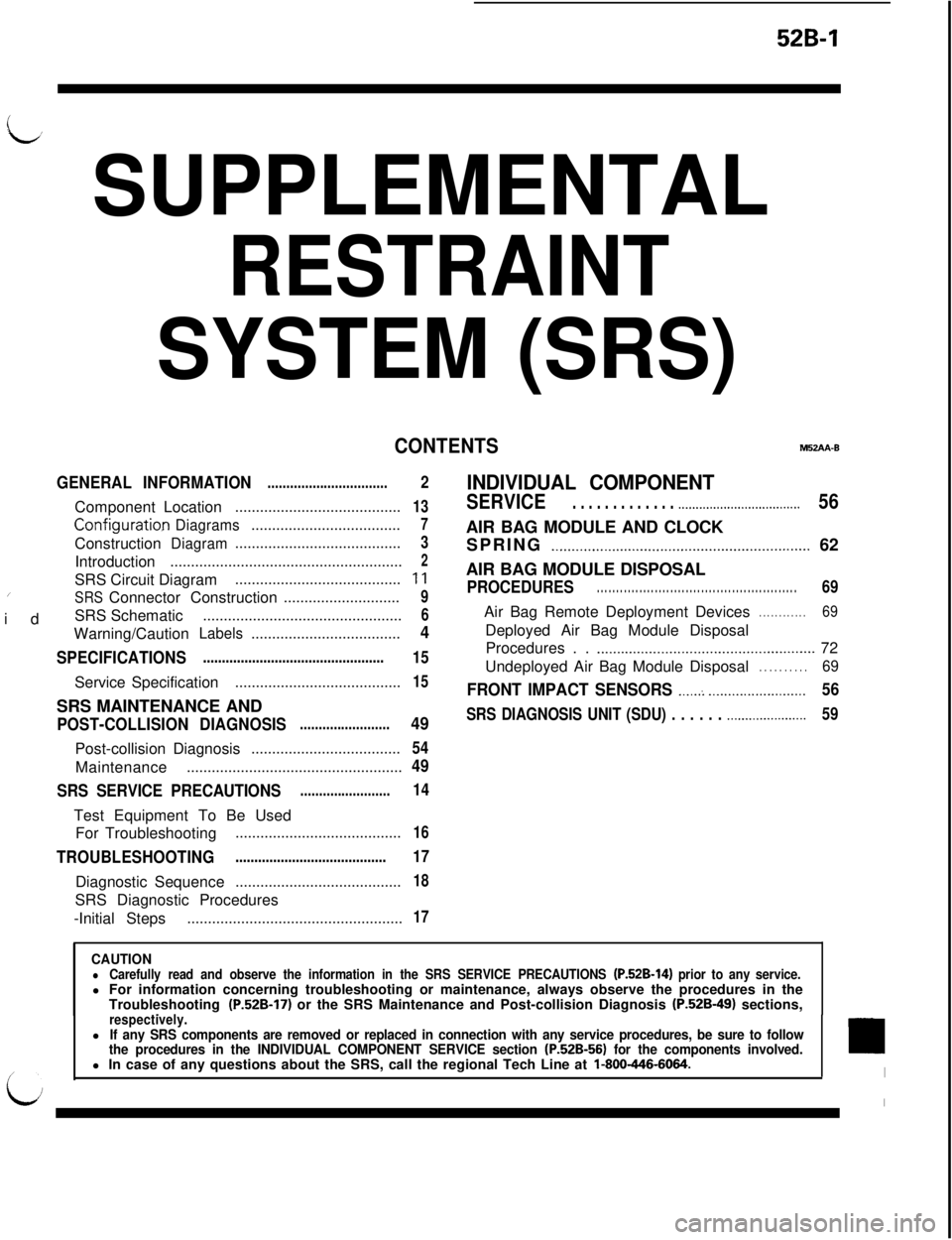
528-l
L’ SUPPLEMENTAL
RESTRAINT
SYSTEM (SRS)
CONTENTSM52AA-B
GENERAL INFORMATION
................................ComponentLocation
........................................
Configurati0.nDiagrams....................................Construction
Diagram........................................Introduction
........................................................SRS Circuit Diagram
......................................../idSRSConnector Construction............................SRS Schematic
................................................Warning/Caution
Labels....................................
SPECIFICATIONS................................................ServiceSpecification
........................................SRS MAINTENANCE AND
POST-COLLISION DIAGNOSIS........................Post-collisionDiagnosis
....................................Maintenance
....................................................
SRS SERVICE PRECAUTIONS........................Test Equipment To Be Used
For Troubleshooting
........................................
TROUBLESHOOTING........................................DiagnosticSequence
........................................SRS Diagnostic Procedures
-Initial Steps
....................................................
2
13
7
3
2
11
9
6
4
15
15
49
54
49
14
16
17
18
17
INDIVIDUAL COMPONENT
SERVICE. . . . . . . . . . . . . .._................................56AIR BAG MODULE AND CLOCK
SPRING
._..........._......................._.........._............... 62
AIR BAG MODULE DISPOSAL
PROCEDURES. . . . . . . . . . . . . . . . . . . . . . . . . . . . . . . . . . . . . . . . . . . . . . . . . . . .69Air Bag Remote Deployment Devices
. . . . . . . . . . . .69Deployed Air Bag Module Disposal
Procedures . .
.._..........._....................................... 72
Undeployed Air Bag Module Disposal
. . . . . . . . . .69
FRONT IMPACT SENSORS ._....: _._..._..................56
SRS DIAGNOSIS UNIT (SDU) . . . . . . .._...................59
CAUTIONlCarefully read and observe the information in the SRS SERVICE PRECAUTIONS (P.52B-14) prior to any service.l For information concerning troubleshooting or maintenance, always observe the procedures in the
Troubleshooting
(P.52B-17) or the SRS Maintenance and Post-collision Diagnosis (P.52B-49) sections,_respectively.lIf any SRS components are removed or replaced in connection with any service procedures, be sure to follow
the procedures in the INDIVIDUAL COMPONENT SERVICE section (P.52B-56) for the components involved.l In case of any questions about the SRS, call the regional Tech Line at l-800-446-6064.
Page 1012 of 1146
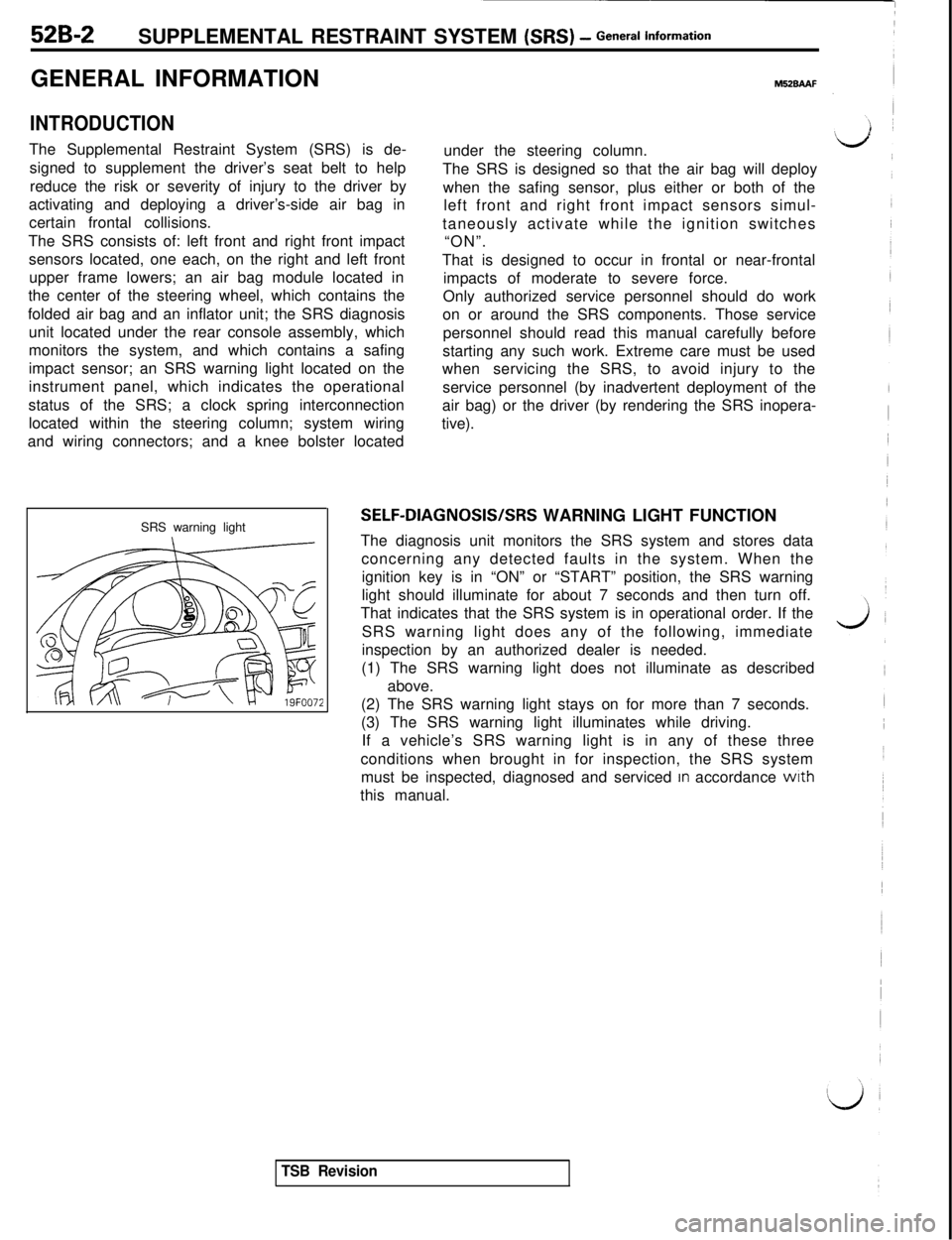
52B-2SUPPLEMENTAL RESTRAINT SYSTEM (SRS) - General informationGENERAL INFORMATION
INTRODUCTIONThe Supplemental Restraint System (SRS) is de-
signed to supplement the driver’s seat belt to help
reduce the risk or severity of injury to the driver by
activating and deploying a driver’s-side air bag in
certain frontal collisions.
The SRS consists of: left front and right front impact
sensors located, one each, on the right and left front
upper frame lowers; an air bag module located in
the center of the steering wheel, which contains the
folded air bag and an inflator unit; the SRS diagnosis
unit located under the rear console assembly, which
monitors the system, and which contains a safing
impact sensor; an SRS warning light located on the
instrument panel, which indicates the operational
status of the SRS; a clock spring interconnection
located within the steering column; system wiring
and wiring connectors; and a knee bolster located
SRS warning light
M52BAAFunder the steering column.
The SRS is designed so that the air bag will deploy
when the safing sensor, plus either or both of the
left front and right front impact sensors simul-
taneously activate while the ignition switches
“ON”.
That is designed to occur in frontal or near-frontal
impacts of moderate to severe force.
Only authorized service personnel should do work
on or around the SRS components. Those service
personnel should read this manual carefully before
starting any such work. Extreme care must be used
whenservicing the SRS, to avoid injury to the
service personnel (by inadvertent deployment of the
air bag) or the driver (by rendering the SRS inopera-
tive).
SELF-DIAGNOSIS/SRS WARNING LIGHT FUNCTION
The diagnosis unit monitors the SRS system and stores data
concerning any detected faults in the system. When the
ignition key is in “ON” or “START” position, the SRS warning
light should illuminate for about 7 seconds and then turn off.
That indicates that the SRS system is in operational order. If the
SRS warning light does any of the following, immediate
inspection by an authorized dealer is needed.
(1) The SRS warning light does not illuminate as described
above.
(2) The SRS warning light stays on for more than 7 seconds.
(3) The SRS warning light illuminates while driving.
If a vehicle’s SRS warning light is in any of these three
conditions when brought in for inspection, the SRS system
must be inspected, diagnosed and serviced
In accordance wrth
this manual.
TSB Revision
Page 1014 of 1146
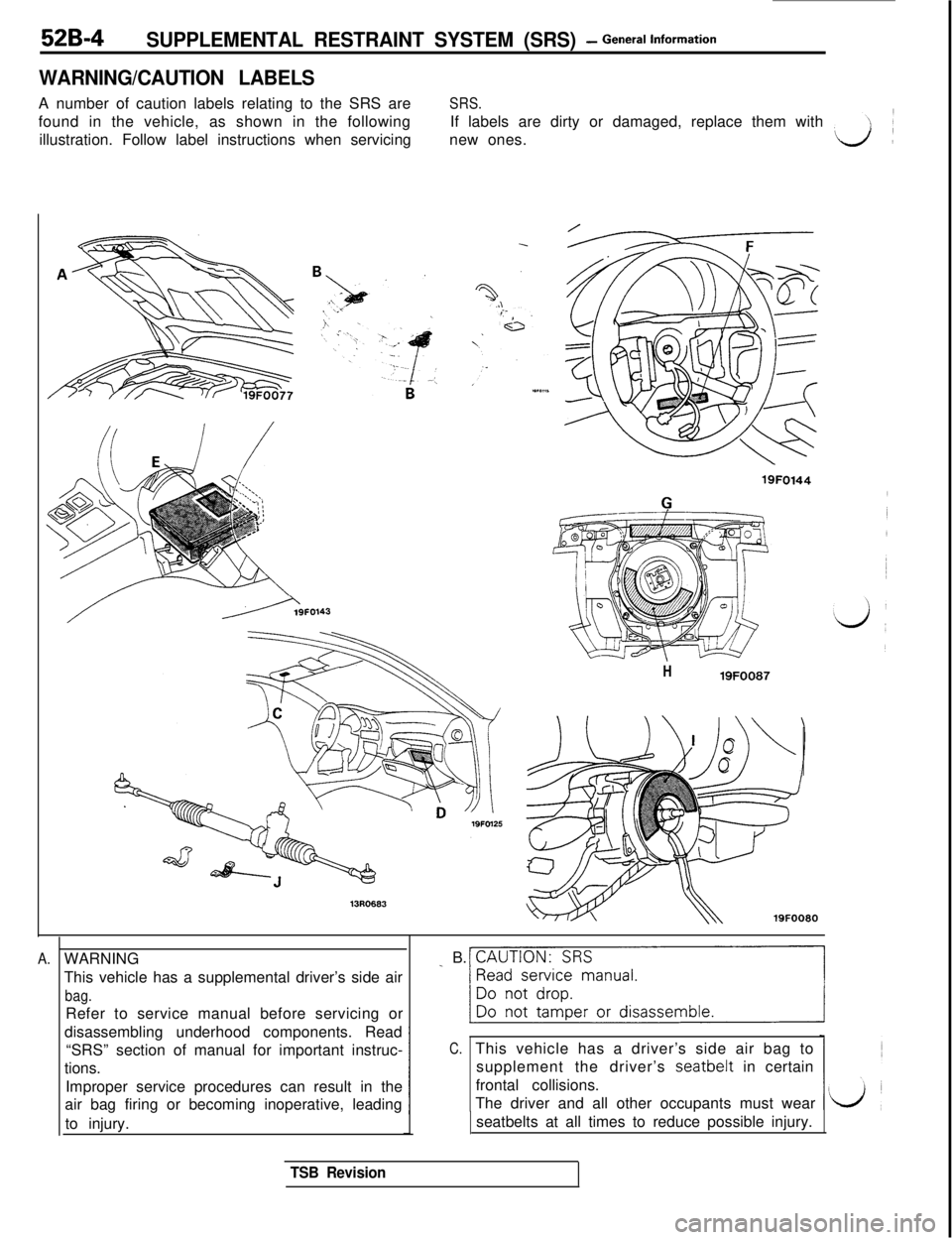
52B-4SUPPLEMENTAL RESTRAINT SYSTEM (SRS) - General lnform=*ion
WARNING/CAUTION LABELSA number of caution labels relating to the SRS are
SRS.found in the vehicle, as shown in the followingIf labels are dirty or damaged, replace them with
illustration. Follow label instructions when servicingnew ones.
//----?9FO143
A.
H19FOO87
19FOO80WARNING
This vehicle has a supplemental driver’s side air
bag.Refer to service manual before servicing or
disassembling underhood components. Read
“SRS” section of manual for important instruc-
tions.
Improper service procedures can result in the
air bag firing or becoming inoperative, leading
to injury.
_ B. CAUTION: SRS
~1
C.This vehicle has a driver’s side air bag to
supplement the driver’s
seatbelt in certain
frontal collisions.
The driver and all other occupants must wear
seatbelts at all times to reduce possible injury.
TSB Revision
Page 1015 of 1146
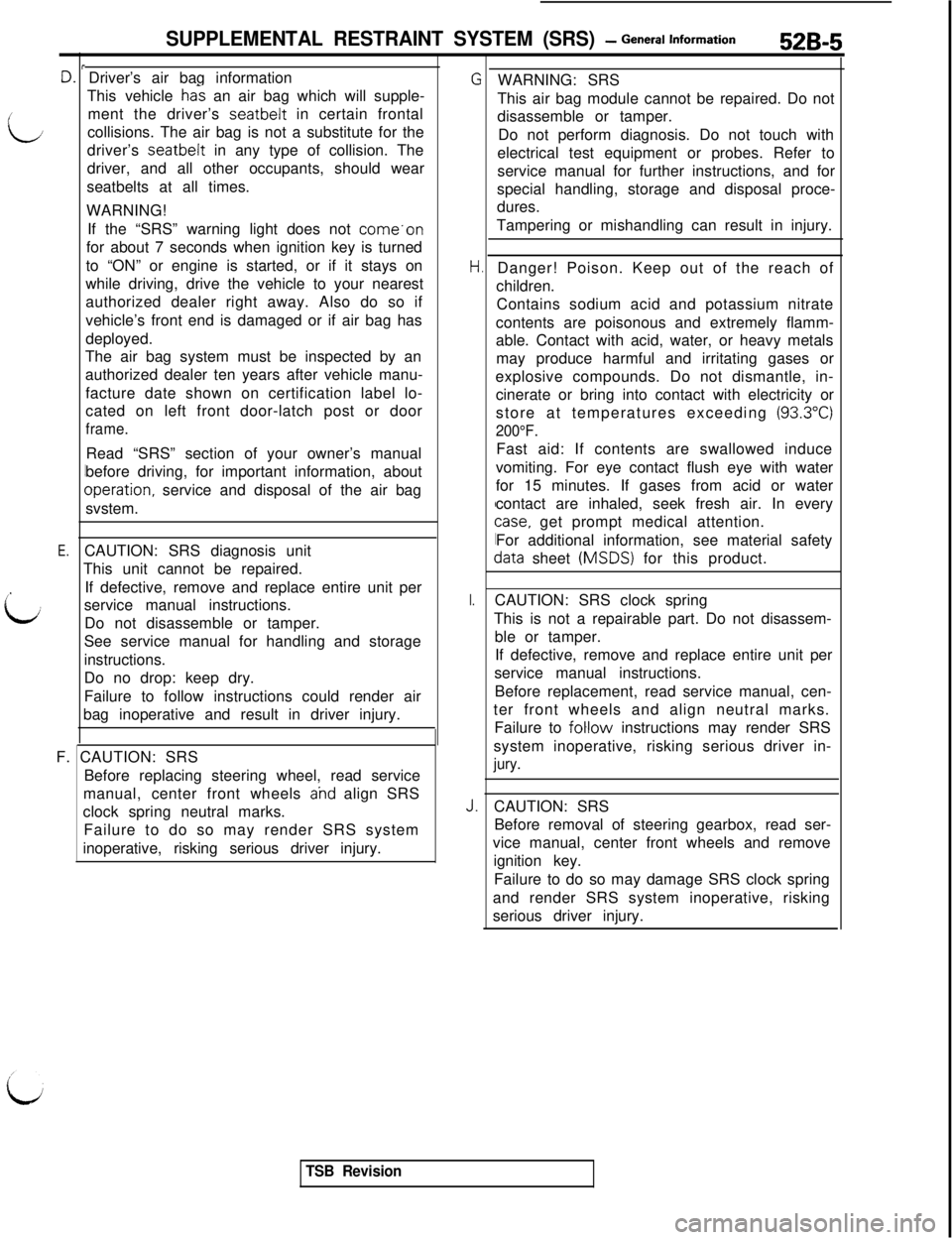
SUPPLEMENTAL RESTRAINT SYSTEM (SRS) - General lnform=*ion52B-5
r1.c
L
E.
,
iiCAUTION: SRS diagnosis unit
This unit cannot be repaired.
If defective, remove and replace entire unit per
service manual instructions.
Do not disassemble or tamper.
See service manual for handling and storage
instructions.Driver’s air bag information
This vehicle
ha% an air bag which will supple-
ment the driver’s seatbelt in certain frontal
collisions. The air bag is not a substitute for the
driver’s seatbelt in any type of collision. The
driver, and all other occupants, should wear
seatbelts at all times.
WARNING!
If the “SRS” warning light does not come.on
for about 7 seconds when ignition key is turned
to “ON” or engine is started, or if it stays on
while driving, drive the vehicle to your nearest
authorized dealer right away. Also do so if
vehicle’s front end is damaged or if air bag has
deployed.
The air bag system must be inspected by an
authorized dealer ten years after vehicle manu-
facture date shown on certification label lo-
cated on left front door-latch post or door
frame.Read “SRS” section of your owner’s manual
before driving, for important information, about
Dperation, service and disposal of the air bag
svstem.
Do no drop: keep dry.
Failure to follow instructions could render air
bag inoperative and result in driver injury.
F. CAUTION: SRS
Before replacing steering wheel, read service
manual, center front wheels
ahd align SRS
clock spring neutral marks.
Failure to do so may render SRS system
inoperative, risking serious driver injury.
I.
J.WARNING: SRS
This air bag module cannot be repaired. Do not
disassemble or tamper.
Do not perform diagnosis. Do not touch with
electrical test equipment or probes. Refer to
service manual for further instructions, and for
special handling, storage and disposal proce-
dures.
Tampering or mishandling can result in injury.
Danger! Poison. Keep out of the reach of
children.
Contains sodium acid and potassium nitrate
contents are poisonous and extremely flamm-
able. Contact with acid, water, or heavy metals
may produce harmful and irritating gases or
explosive compounds. Do not dismantle, in-
cinerate or bring into contact with electricity or
store at temperatures exceeding
(93.3”C)
200°F.Fast aid: If contents are swallowed induce
vomiting. For eye contact flush eye with water
for 15 minutes. If gases from acid or water
contact are inhaled, seek fresh air. In every
case, get prompt medical attention.
For additional information, see material safety
data sheet (MSDS) for this product.
CAUTION: SRS clock spring
This is not a repairable part. Do not disassem-
ble or tamper.
If defective, remove and replace entire unit per
service manual instructions.
Before replacement, read service manual, cen-
ter front wheels and align neutral marks.
Failure to
foHow instructions may render SRS
system inoperative, risking serious driver in-
jury.CAUTION: SRS
Before removal of steering gearbox, read ser-
vice manual, center front wheels and remove
ignition key.
Failure to do so may damage SRS clock spring
and render SRS system inoperative, risking
serious driver injury.
TSB Revision
Page 1024 of 1146
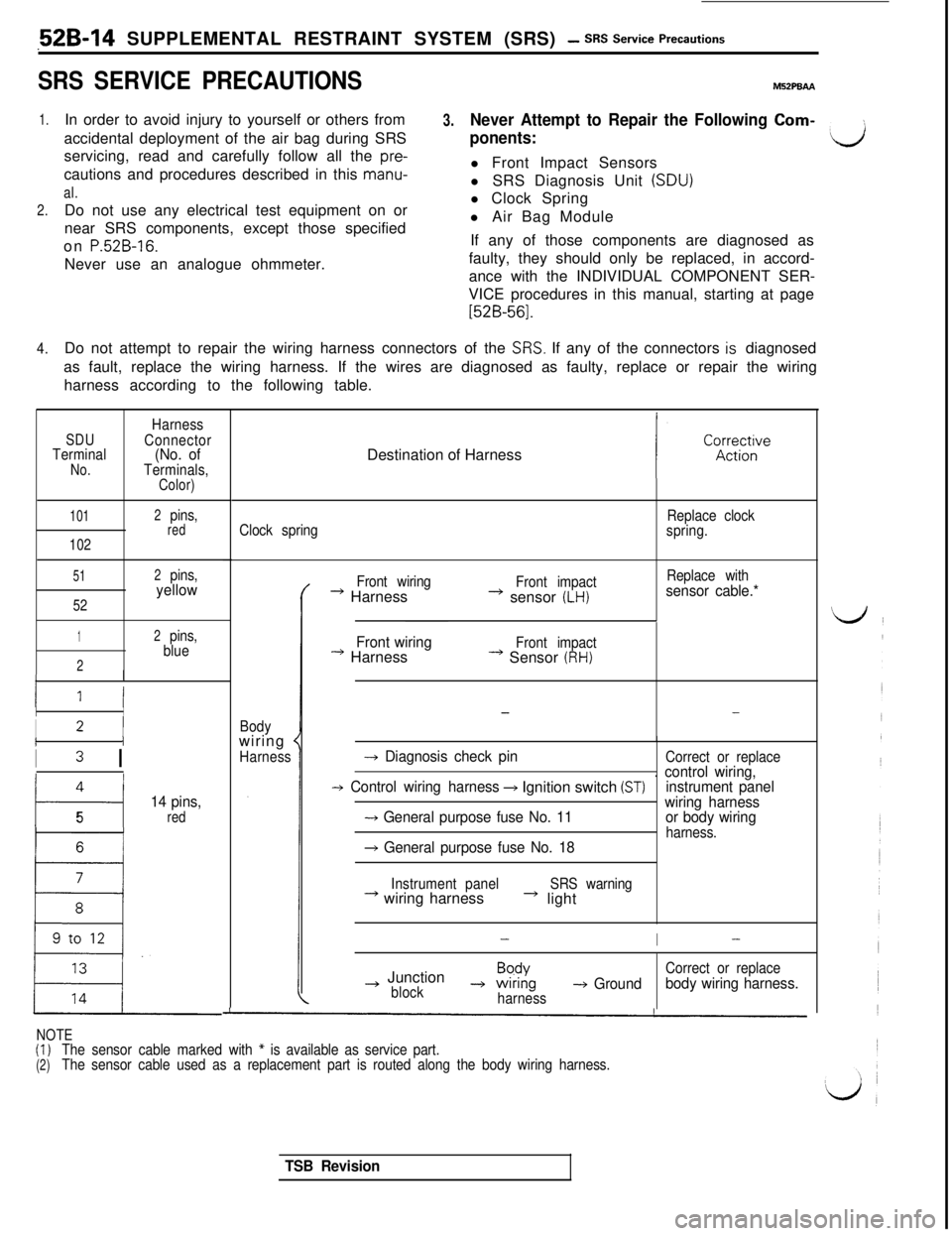
.52B-14 SUPPLEMENTAL RESTRAINT SYSTEM (SRS) - SRS Service Precautions
SRS SERVICE PRECAUTIONSMBZPBAA
1.In order to avoid injury to yourself or others from3.accidental deployment of the air bag during SRSNever Attempt to Repair the Following Com-servicing, read and carefully follow all the
pre-
ponents:dcautions and procedures described in this
manu-l Front Impact Sensors
al.l SRS Diagnosis Unit (SDU)
2.Do not use any electrical test equipment on orl Clock Spring
near SRS components, except those specifiedl Air Bag Module
on
P.52B-16.If any of those components are diagnosed as
Never use an analogue ohmmeter.faulty, they should only be replaced, in accord-
ance with the INDIVIDUAL COMPONENT SER-
VICE procedures in this manual, starting at page
[52B-561.
4.Do not attempt to repair the wiring harness connectors of the
SRS. If any of the connectors is diagnosed
as fault, replace the wiring harness. If the wires are diagnosed as faulty, replace or repair the wiring
harness according to the following table.
SDUTerminalNo.
Harness
Connector
(No. ofTerminals,Color)
101
102
2pins,red
51
52
2pins,yellow
12pins,
blue
2
II
II
I2 IIi
I3 I
4
t---i
14 pins,
5red
16 t
LDestination of Harness
Clock springReplace clock
spring.
Bodywiring
*
HarnessFront wiring
* HarnessFront impact+ sensor (LH)
Replace withsensor cable.*
Front wiring
--) HarnessFront impact* Sensor (RH)
--
-+ Diagnosis check pinCorrect or replace
-+ Control wiring harness+ Ignition switch (ST). control wiring,
instrument panel
-+ General purpose fuse No. 11wiring harness
or body wiringharness.+ General purpose fuse No. 18
Instrument panel+ wiring harnessSRS warning* light
-I-
~ JunctionBpdYCorrect or replace
block-+ wrnng-+ Groundharnessbody wiring harness.
NOTE(I)
(2)The sensor cable marked with * is available as service part.
The sensor cable used as a replacement part is routed along the body wiring harness.
TSB Revision